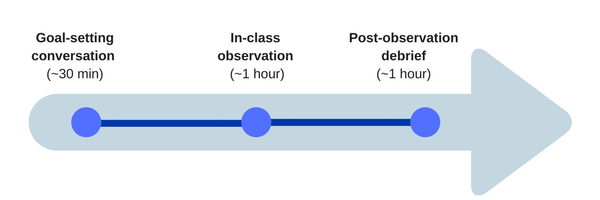This Week for Faculty: Supporting Reflective Teaching Practice
In Becoming a Critical Reflective Teacher (2017), Brookfield suggests the use of four lenses of critical reflection—colleagues’ perceptions, theory, students’ eyes, and personal experience—to see your teaching practices from different angles (p. 61-77).
To make critical reflection part of your ongoing practice, consider the following:
Reflect on your teaching experiences
 Think about your teaching experiences. Principle 5 in the Guide for Inclusive Teaching at Columbia, encourages self-reflection. Build in time for metacognitive work (explore the CTL’s resource on metacognition) before, during, and after a course. Keep track of things to keep or modify for next time. For instance, after every class session, annotate class session plans or briefly engage in reflective writing (in a journal or digital space). Ask yourself: what worked well? What could be improved? What would I do differently the next time I teach this class session? And document what changes you plan to make.
Think about your teaching experiences. Principle 5 in the Guide for Inclusive Teaching at Columbia, encourages self-reflection. Build in time for metacognitive work (explore the CTL’s resource on metacognition) before, during, and after a course. Keep track of things to keep or modify for next time. For instance, after every class session, annotate class session plans or briefly engage in reflective writing (in a journal or digital space). Ask yourself: what worked well? What could be improved? What would I do differently the next time I teach this class session? And document what changes you plan to make.
Request a CTL teaching observation to receive feedback on your teaching!
Invite a CTL consultant to observe your class and share formative feedback. Gain perspective, validate your strengths, and identify areas of your teaching that you would like to work on. Our consultants can help you think through your course goals, reflect on your teaching practices that support your students’ learning, and plan next steps for small chances to meet your teaching objectives. This formative observation service includes a pre-observation goal setting conversation, the observation, and a post-observation debrief.

Collect feedback for your students and TAs
 Check in with your students at various points within the semester, and ask them how they are experiencing the learning. Collect feedback early in the semester. This can be done via an anonymous survey (e.g., using Google Form).
Check in with your students at various points within the semester, and ask them how they are experiencing the learning. Collect feedback early in the semester. This can be done via an anonymous survey (e.g., using Google Form).
The CTL’s Early and Mid-Semester Student Feedback resource outlines two approaches for collecting feedback from your students: the start, stop, continue method and a question bank for gathering feedback from students.
As you explore and interpret the data collected, consider taking these actions:
- Identify patterns or common themes in the comments.
- Note what students found most useful in supporting their learning. Based on what students thought worked well, what practices will you continue doing?
- Reflect on the insights gained, and decide on the areas for improvement that would enhance the student learning experience. What changes to the course design and/or teaching practices might be needed?
To ensure that students feel heard, share back aggregate responses or themes, and address the points raised and what students can expect for the remainder of the semester.
Ask your TAs (if applicable) for feedback. They provide valuable insights into how students may be experiencing the course and common questions or issues that students bring to the course.
The CTL is available to consult with you as you design your feedback survey and interpret the results. Reach out to us at ctlfaculty@columbia.edu.
Connect with colleagues around teaching
 Talk to colleagues about teaching issues or challenges, and brainstorm solutions. This can help place our teaching in perspective. Join us for an upcoming CTL event to connect with colleagues across campus.
Talk to colleagues about teaching issues or challenges, and brainstorm solutions. This can help place our teaching in perspective. Join us for an upcoming CTL event to connect with colleagues across campus.
Learn from colleagues and their experiences experimenting with innovations in their classrooms. Read, listen, and watch Columbia colleagues share their reflections and experiences through the Teaching Transformations; the 2023 Celebration of Teaching and Learning Symposium or past Symposiums; Faculty Spotlights; and the Dead Ideas in Teaching and Learning podcast.
Gain new insights into teaching and learning by observing a colleague’s class. Whether you are exploring a new pedagogical approach, considering integrating a new instructional technology or seeking inspiration, reciprocal peer observation is a great way to learn from each other. Ask a colleague if you can visit their classroom and experience it as a learner would. Reflect on what you observed, and have an informal conversation to learn more about the how and why of their teaching and the planning process.
Explore the literature
 Explore the teaching and learning literature to discover evidence-based approaches to incorporate into your practice. Various higher education and disciplinary journals publish articles on evidence-based teaching and learning practices. Access e-journals through Columbia Libraries.
Explore the teaching and learning literature to discover evidence-based approaches to incorporate into your practice. Various higher education and disciplinary journals publish articles on evidence-based teaching and learning practices. Access e-journals through Columbia Libraries.
Don’t have time to read the literature? Explore the CTL’s on-demand resources for distillations on the literature on various teaching and learning topics.
The CTL is here to help!
Office Hours
Join us for office hours via Zoom (or phone) Monday-Friday, 9:00am-5:00pm to have your teaching with instructional technology questions answered. Through September 22, walk in to 212 Butler for in-person support or schedule an in-person appointment any time by contacting ColumbiaCTL@columbia.edu.
Consultations
Schedule an in-person or virtual consultation to discuss any teaching and learning need by emailing ctlfaculty@columbia.edu or email the CTL Learning Designer assigned to your school or department.